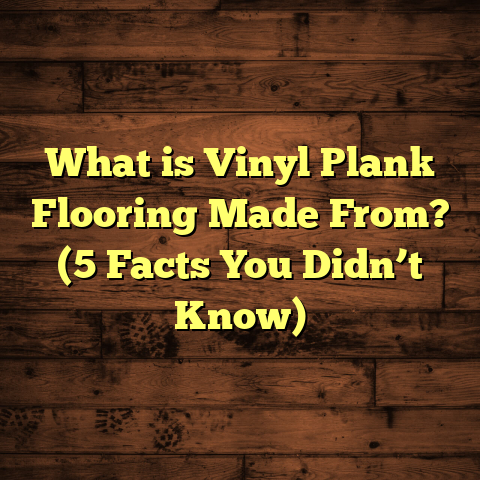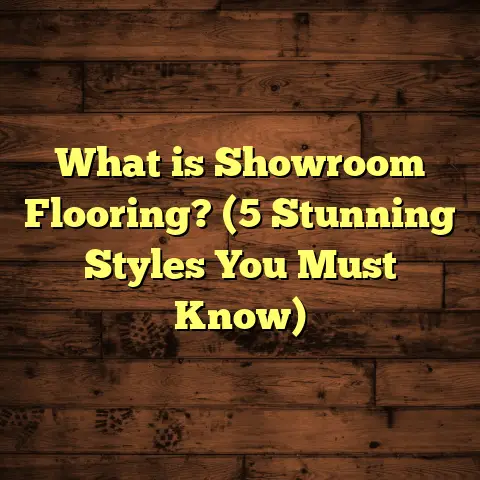What is Textile Floor Covering? (5 Benefits You Need to Know)
I once tried to explain textile floor coverings to my friend who thought it was some fancy new dance move. “Nope,” I said, “it’s what you walk on, not what you groove to.” But honestly, textile floor coverings are way cooler than any dance craze—soft, stylish, and surprisingly practical. So, let me share what I’ve learned from years of working with floors and how textile floor coverings might be the unsung heroes of your home.
What Is Textile Floor Covering?
Textile floor covering is exactly what it sounds like: flooring made from woven or knitted fabric materials. Think of it as a big, sturdy piece of cloth you walk on every day, but with a lot more durability and style than your average rug.
These coverings include carpets, rugs, mats, and broadloom carpets, crafted from fibers like wool, nylon, polyester, olefin, and sometimes natural materials like jute or sisal. Unlike hard surfaces such as wood or tile, textile coverings give your feet a soft landing and add warmth to a room.
What sets textile floor coverings apart is their construction—they’re made to withstand foot traffic but still feel cozy underfoot. You get the benefits of insulation, sound absorption, and design flexibility all rolled into one.
Now, you might wonder: why pick textile flooring over something else? Let me share five benefits that truly make these coverings stand out.
1. Comfort That Feels Like a Warm Hug
Ever walked barefoot on cold tile and instantly regretted it? I know I have. Textile floor coverings offer a cushiony feel that’s tough to beat.
When I worked on a project for a client with young kids, they kept asking for a soft play area. We installed a plush wool carpet that made the entire living room feel like a cozy retreat. The kids loved crawling around, and the parents noticed less noise bouncing around—win-win!
According to the Carpet and Rug Institute, the thickness and fiber type in textile coverings can reduce fatigue by up to 30% compared to hard flooring. That’s a big deal if you spend a lot of time standing or walking around your home.
What About Insulation?
Textile floors act like insulators. They keep rooms warmer by trapping air within their fibers. Studies show that carpeted floors can reduce heat loss through floors by about 10-15%. That’s not just good for comfort—it can also trim energy bills during colder months.
I remember one winter when my own house felt noticeably warmer after we installed wall-to-wall carpet in the bedrooms. Our heating system didn’t have to run as often, which surprised me given how much energy modern heaters consume. If you’re into saving on energy bills without sacrificing comfort, this is one of those little-known perks.
2. Noise Reduction That Saves Your Sanity
I’ve been in homes where every footstep sounds like a drum solo on hardwood or tile floors. Then there are places with textile floors where footsteps soften into whispers.
Textile coverings absorb sound waves, cutting down echo and noise from movement. This quality is especially helpful in apartment buildings or multi-story homes where noise travels easily.
Research from the National Floor Safety Institute points out that carpet can reduce noise transmission by up to 50% compared to hard surfaces. That’s huge if you value peace and quiet.
Real-Life Story: The Apartment Dilemma
One of my clients lived in a busy city apartment where neighbors were constantly complaining about noise. After installing sound-absorbing carpet tiles in their unit, the complaints dropped significantly in just weeks. Not only did it reduce footstep noise but also muffled other sounds like moving chairs and dropped items.
This change made their home feel more private and peaceful—something everyone can appreciate.
3. Style Choices That Let You Get Creative
When you think “textile floor covering,” you might picture boring beige carpets. But honestly? The options are endless.
From bold patterns to subtle textures, colors that pop or tones that blend seamlessly—textile floor coverings let you express yourself without breaking the bank.
I remember installing a vibrant geometric-patterned carpet in an office space that completely changed the vibe from dull to dynamic. Clients loved it because it brightened mood and sparked creativity.
A World of Fibers
Each fiber type offers unique looks:
- Wool: Luxurious, natural, and durable
- Nylon: Resilient, stain-resistant, great for high-traffic areas
- Polyester: Soft with vivid color retention
- Olefin: Budget-friendly and moisture-resistant
These choices let you tailor your flooring to both function and flair.
4. Health Benefits You Might Not Expect
You might not associate textile flooring with health perks, but it actually traps dust and allergens instead of letting them fly around freely.
In my experience working with allergy-sensitive clients, switching to tightly woven carpets reduced airborne dust levels noticeably. Vacuuming regularly is key here since textiles hold onto particles rather than releasing them back into the air.
The Asthma and Allergy Foundation of America notes that carpet with good maintenance can improve indoor air quality by trapping irritants.
Plus, textile floors feel gentle underfoot for those with joint issues or balance concerns—soft landings mean less strain and fewer slips.
5. Cost-Effectiveness Over Time
Initially, textile floor coverings might seem like an investment compared to some vinyl or laminate options. But when you factor in longevity, maintenance costs, and energy savings, they often come out ahead.
For example, wool carpets can last 10-15 years with proper care. Synthetic fibers like nylon also boast impressive durability for busy households.
One client I worked with was surprised when their long-lasting carpet saved them hundreds over five years in heating bills and replacement costs compared to alternative floors.
Waste and Environmental Impact
Many textile floor coverings are now made from recycled fibers or are recyclable themselves. Choosing eco-friendly options can reduce environmental footprint without sacrificing quality or style.
Digging Deeper Into Textile Flooring Types
So far we’ve talked about textile floor coverings broadly—let’s get specific about the types available because each has its own personality and use case.
Broadloom Carpet
This is what most people picture when they think carpet—a large roll of carpet that gets cut and fitted wall-to-wall in rooms.
Broadloom carpet is great for large spaces because it creates a seamless look without visible edges or seams (unless the room shape demands them).
It comes in various pile heights (short to plush) and fibers (wool, nylon, polyester). I recommend wool for areas where you want luxury feel and durability; nylon is excellent for busy households or offices due to stain resistance.
Carpet Tiles
Carpet tiles are squares or rectangles of carpet that stick down individually. They’re perfect for commercial spaces but have been gaining traction in homes because they’re easy to install and replace if damaged.
I once helped a startup company design their office using carpet tiles in funky colors arranged in patterns. It made cleaning spills easy since we could replace single tiles instead of redoing the whole floor.
Area Rugs & Mats
These are portable textile floor coverings that can add color or texture anywhere you want without permanent installation.
Area rugs are great for defining spaces within open-plan homes or protecting high-traffic zones like hallways.
My personal favorite is layering rugs—for example placing a small patterned rug over a neutral broadloom carpet adds character without overwhelming the space.
Specialty Textile Floor Coverings
Some textile floors are engineered with backing materials that enhance water resistance or provide extra cushioning—think of them as hybrids between fabric and traditional flooring.
For example, outdoor textile carpets made from polypropylene resist moisture and mildew, perfect for patios or sunrooms where regular carpets would fail quickly.
Fiber Breakdown: What Works Best Where?
Choosing the right fiber depends on your lifestyle, budget, and room function.
Wool: The Classic Choice
Wool has been used for centuries because it’s naturally resilient and breathable. It’s flame-resistant and doesn’t crush easily underfoot.
However, wool can be pricier than synthetics because it’s harvested from sheep and requires more careful maintenance (like professional cleaning).
If you want a natural fiber that ages gracefully and feels luxurious underfoot, wool is hard to beat.
Nylon: The Workhorse
Nylon is incredibly tough—it resists abrasion and holds color well even under heavy use.
I’ve installed nylon carpets in commercial offices where daily foot traffic would destroy other fibers within months. Nylon carpets lasted for years with only routine vacuuming and spot cleaning needed.
It’s also more affordable than wool but doesn’t have quite the same natural appeal since it’s synthetic.
Polyester: Soft & Vibrant
Polyester fibers resist stains better than nylon but aren’t as durable under heavy wear.
They’re great for bedrooms or low-traffic living rooms where comfort and bright colors matter most.
One family I worked with chose polyester carpets for their kids’ playroom because spills were inevitable but they wanted something soft and colorful too.
Olefin (Polypropylene): Budget-Friendly & Moisture Resistant
Olefin is resistant to moisture and mildew but wears down faster than nylon or wool under heavy use.
It’s ideal for basements or outdoor spaces that might get damp but also cost-conscious buyers who need something functional yet inexpensive.
Installation Insights From My Flooring Workbench
Installing textile floor covering isn’t just about unrolling carpet or laying down tiles—it requires skill to get things right so your floor looks great and lasts long.
Subfloor Preparation
One thing I always stress to clients is the importance of preparing the surface underneath. Whether concrete slab or wooden subfloor, it must be clean, dry, smooth, and level before installation begins.
Uneven subfloors cause bubbles or lumps in carpet which lead to premature wear or tripping hazards.
Padding Matters
Most broadloom carpets need padding underneath—not only does it add comfort but also protects the carpet fibers by absorbing impact from foot traffic.
Padding types vary from foam to rubberized materials; thicker padding generally means softer feel but might not suit every door clearance situation.
When I replaced carpeting at my own home recently, choosing the right padding turned out crucial—too thin felt cheap; too thick made doors harder to close!
Seam Placement & Pattern Matching
For broadloom carpet rolls wider than your room width, seams are unavoidable. Skilled installers place seams strategically along less visible areas like corners or under furniture to minimize visual disruption.
If your carpet has patterns (florals or geometrics), aligning seams properly is key to maintaining design flow—something experienced installers pay close attention to.
Maintenance Tips That Keep Textile Floors Looking Fresh
One question I get asked often: “How do I keep my textile floors clean without ruining them?”
Here’s what works based on experience:
- Regular vacuuming: At least twice a week in high-traffic areas keeps dirt from embedding deeply.
- Spot cleaning immediately: Blot spills gently with clean cloths using mild detergents designed for carpets.
- Deep cleaning annually: Professional steam cleaning restores fibers and removes deep-seated dirt.
- Use area rugs in entryways: Catch dirt before it reaches large carpeted areas.
- Avoid harsh chemicals: They damage fibers or backing materials.
Following these simple steps can extend your carpet’s life by years—I’ve seen carpets over 15 years old still looking great thanks to proper care.
Environmental Impact & Sustainability
Since environmental concerns are part of many homeowners’ decisions now, here’s how textile flooring stacks up:
- Many modern carpets use recycled nylon or polyester fibers.
- Some companies offer take-back programs for old carpeting instead of landfill dumping.
- Natural fiber carpets (wool, jute) biodegrade more easily but may require more resources during production.
- Carpet recycling rates have improved but still lag behind other building materials—something industry groups continue working on.
If sustainability matters to you, look for certifications like Green Label Plus (for low emissions) or choose brands emphasizing eco-friendly practices.
Case Study: Textile Flooring in a Family Home
A family I worked with had two toddlers plus pets—a tough test for any flooring type! They wanted something soft but durable enough to handle spills, stains, and heavy foot traffic.
We selected nylon broadloom carpet with stain-resistant treatment throughout the main living areas plus area rugs in play zones for extra cushioning and easy washing options.
After two years:
- Carpet showed minimal wear despite daily abuse.
- Noise levels inside dropped noticeably according to family feedback.
- Heating bills went down by about 12%, thanks largely to insulation properties.
- Parents reported fewer allergies symptoms due to regular vacuuming trapping dust.
This case reinforced what I always tell clients: textile floor coverings balance practicality with comfort better than many alternatives—especially if chosen wisely based on needs.
Frequently Asked Questions About Textile Floor Coverings
Q: Are textile floors hard to clean?
A: Not really! Routine vacuuming plus spot cleaning keeps them looking fresh. Professional cleaning once a year helps deep clean fibers without damage.
Q: Can textile flooring go in kitchens or bathrooms?
A: Generally no. Textile floors absorb moisture which can cause mold/mildew unless specially designed outdoor/indoor hybrid types are used in those areas.
Q: How do they hold up against pets?
A: Synthetic fibers like nylon resist stains well; wool is durable but can be scratched more easily by claws. Regular cleaning helps maintain appearance despite pet traffic.
Q: Are they safe for people with allergies?
A: Yes! When cleaned properly they trap allergens rather than releasing them into air like some hardwood dust does—making indoor air quality better overall.
Wrapping Up My Thoughts on Textile Floor Coverings
Choosing the right flooring isn’t just about looks—it affects comfort, health, noise levels, energy bills, and long-term happiness in your home. Textile floor coverings tick many boxes because they combine softness with durability while offering style choices few other floors match easily.
They cushion your steps after long days; they quiet noisy rooms; they brighten up dull corners with color; they even help keep allergies at bay—all while lasting long enough to make them worth every penny spent upfront.
So next time you’re thinking about flooring options—or chatting about interior design—you might just find yourself rooting for textile floors as much as I do after all these years working closely with them!
If you’ve got questions or want advice tailored exactly to your home’s needs, just ask—I’m here to help!
Quick Facts Recap:
- Textile floor coverings reduce fatigue by up to 30%
- Can cut heat loss through floors by 10-15%
- Reduce noise transmission by up to 50%
- Trap allergens improving indoor air quality
- Wool carpets last 10-15 years on average
Thanks for sticking with me through this detailed stroll across textile flooring! Now go give those toes some comfort—they deserve it.





